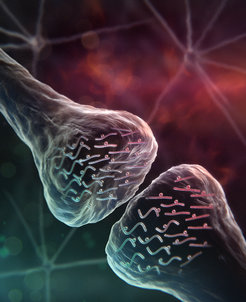Sleep and synaptic rhythms
Chronobiologists show in two articles in the journal Science how critical the sleep-wake cycle is for protein and phosphorylation dynamics in synapses to ultimately regulate its activity.

The chronobiologist Maria Robles together with Matthias Mann and Jürgen Cox from the MPI of Biochemistry, used mass spectrometry-based quantitative proteomics to profile daily dynamics of protein and phosphorylation in in vivo isolated synapses from mouse forebrain. Phosphorylation means that phosphate molecules bind to proteins and change their structure slightly. The phosphate molecule thereby functions like a protein switch, capable of changing the protein activity and function.
For the studies in Science, the team investigated how synaptic proteome and phosphoproteome are dynamically shaped across the day and how it is affected by sleep deprivation. In one study the group shows that in a normal day, one fourth of the 8,000 phosphorylations in many critical synaptic proteins oscillates with two main peaks: one when the mice wake up and a second one just before they fall asleep. "This suggests that synaptic phosphorylation plays a key role in the regulation of synaptic function in particular at the sleep-wake-sleep transitions," says Maria Robles. This characteristic phosphorylation pattern seems to reflect buildup and dissipation of sleep and wake pressure since sleep deprivation almost completely abolished synaptic phosphorylation rhythms. "Our study shows that key synaptic processes, from house-keeping to plasticity are temporally regulated trough phosphorylation, in response to both sleep and wake pressure,” says Maria Robles, who worked as a postdoctoral fellow for Matthias Mann.
In the second study published in the same issue of Science the same group, in collaboration with a group from the University of Zürich (Steve Brown), has showed that synaptic protein abundance is also rhythmically shaped by sleep-wake cycles. In particular, they demonstrated that synaptic activity triggers the cycling production of proteins from messenger molecules that rhythmically accumulate at the synapses across the day. While protein production completely depends on wake-sleep cycles, messenger molecules travel and accumulate in the synapses predominantly in response to circadian mechanisms.
Original publications
1. F. Brüning, SB Noya, T. Bange, S. Koutsouli, JD Rudolph, S. Tyagarajan, J. Cox, M. Mann, SA Brown, MS Robles: Sleep-wake cycles drive daily dynamics of synaptic phosphorylation, Science, Oktober 2019
2. SB. Noya, D. Colameo, F. Brüning, A. Spinnler, D. Mircsof, L. Opitz, M. Mann, S. K. Tyagarajan, MS Robles, SA Brow: The forebrain synaptic transcriptome is organized by clocks but its proteome is driven by sleep, Science, Oktober 2019
DOI: 10.1126/science.aav2642 und 10.1126/science.aav3617
